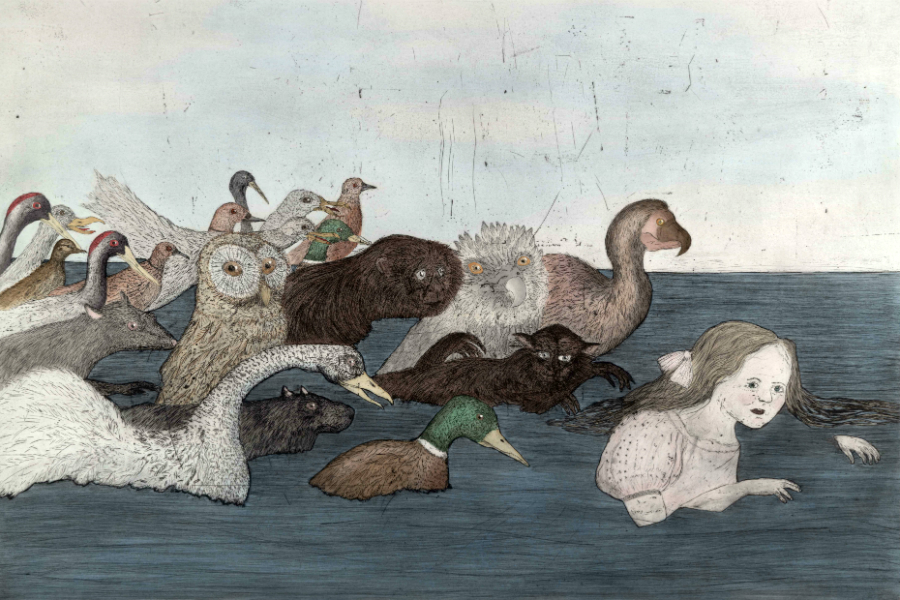Alice in Wonderland at Tate – Reviewed

Rachael Jones pursues the white rabbit into the gallery and comes up smiling…
2012 marks 150 years since Lewis Carroll (or Charles Dodgson, if you prefer) thought up Alice in Wonderland on a boat trip from Oxford to Godstow. To celebrate, TATE Liverpool brought us an exhibition about the book’s enduring influence on art.
The Cheshire Cat, the Mad Hatter, the little girl in a dress and headband – these images are seared into popular consciousness. The history of theatre and cinema is littered with Dodgson’s text, from Walt Disney to Tim Burton and several adaptations in between. So what did the Tate make of it?
En route to the top of the stairs, the walls are decorated with beautifully curving quotes from artists featured in the exhibition. ‘I spent my childhood surrounded by animals, so I particularly enjoy the enchanted world of shape-shifting anthropomorphic beasts that Carroll brings to life,’ says Samantha Sweeting.
Our favourite part of the exhibition came when we got to the top. Two whole galleries dedicated to Dodgson’s life, his relationship to the movers and shakers of the Victorian art world and his friendship with the real-life Alice Liddell. This is Alice through Dodgson’s eyes, and includes some fantastic photographs of Alice taken by the author.
These rooms also contained Dodgson’s original diaries, and the manuscript of the novel he gave to Alice Liddell in 1864. The literature geek in us wept with joy.
The manuscript is a work of art in itself, with Dodgson’s original sketches, his innovative use of typefaces, punctuation and the curious way he cut and pasted words onto the page. It’s fantastic to see it presented as such.
Onward. Alice has been embraced wholeheartedly by several artistic movements over the years. The first to seriously do so was the Surrealist movement of the 1930s, with artists naming Dodgson their ‘surrealist ancestor.’ It’s hard to see a direct link to the little girl in the previous room, but she’s certainly there in spirit, with the artists playing with scale, perspective and the distortion of time and space.
The works of Max Ernst, John Armstrong and Paul Nash are all displayed here, but the crowning glory of this part of the exhibition is definitely Salvador Dali’s series of illustrations to the text.
By the 60s Alice was a pin-up. ‘Chasing the White Rabbit’ became slang for taking LSD, and Alice’s hookah-smoking sessions with giant caterpillars became mind-altering drug trips. Alice as the poster child for psychedelia is presented in all her raving neon glory with Adrian Piper’s swirly LSD paintings, pitching Alice down the rabbit hole headfirst in a swirl of acidic pink and orange.
Into the 21st century and we see a slight shift in focus, with many artists focusing on the troublesome nature of time, Joseph Kosuth’s Clock (One and Five) and Torsten Lauschmann’s Digital Clock (Growing Zeros) both using clocks as the centrepiece of their work.
Virginia Woolf once said that Alice ‘wasn’t a book for children,’ and there’s certainly some art here that would agree with her. Yayoi Kusama’s photographs of naked, polka-painted performers posed around the Alice sculpture in Central Park, an Exorcist-style painting (Millais’ Waking, 1865) that features a little girl staring, terrified, at something sight unseen.
And there are moments of pure macabre; like Samantha Sweeting’s Run Rabbit Run, a video loop of the artist manipulating the legs of a rabbit to look like it’s running when it’s actually dead. Throw in a giant pornographic billboard (Fiona Banner’s Arsewoman in Wonderland) and several neon-lit euphemisms for vagina (Jason Rhoades’ Tate Touche from My Madinah) and you’ve got something distinctly 18-rated.
Hands-down, the piece we enjoyed most was White Alice (After Lewis Carroll), a 1989 piece by Tim Rollins and art collective Kids on the Street. It features every page of Alice laid out, in order, across a giant canvas and subsequently obscured by what appears to be a sheet of white paper. While trying to figure out what on earth was going on, we spotted something. Was that an elbow? It was! And then it all became clear; there was Alice, oversized, jammed into the White Rabbit’s home.
Tate’s Alice is a mixed bag, then. And while this could be a downside to the exhibition we choose to see it a bit differently. Alice’s Adventures in Wonderland is the tale of a young girl’s journey into adulthood, her experiences in Wonderland changing her outlook on the world and her place in it forever and for always. You need only read Through the Looking Glass to realise just how much she’s changed.
So what does this have to do with all this art? It’s simple, really. Alice is ubiquitous because everyone can relate to that moment of ‘waking up,’ of reaching that point in your life where the nature of the world changes. We’ve been there; all these artists have too. It’s that universal feeling that ties these vastly different works of art together.
There’s more work in this exhibition than we can possibly squeeze into this space. So why not go see it for yourself?
Rachael Jones
Image: Kiki Smith Pool of Tears 2 (after Lewis Carroll) 2000, © Courtesy of ULAE, inc
Alice in Wonderland at Tate Liverpool continues until 29th January
£7.20, concessions £5.40





